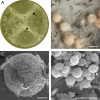Discovery of a sexual cycle in Aspergillus lentulus, a close relative of A. fumigatus
- PMID: 23650087
- PMCID: PMC3697472
- DOI: 10.1128/EC.00040-13
Discovery of a sexual cycle in Aspergillus lentulus, a close relative of A. fumigatus
Abstract
Aspergillus lentulus was described in 2005 as a new species within the A. fumigatus sensu lato complex. It is an opportunistic human pathogen causing invasive aspergillosis with high mortality rates, and it has been isolated from clinical and environmental sources. The species is morphologically nearly identical to A. fumigatus sensu stricto, and this similarity has resulted in their frequent misidentification. Comparative studies show that A. lentulus has some distinguishing growth features and decreased in vitro susceptibility to several antifungal agents, including amphotericin B and caspofungin. Similar to the once-presumed-asexual A. fumigatus, it has only been known to reproduce mitotically. However, we now show that A. lentulus has a heterothallic sexual breeding system. A PCR-based mating-type diagnostic detected isolates of either the MAT1-1 or MAT1-2 genotype, and examination of 26 worldwide clinical and environmental isolates revealed similar ratios of the two mating types (38% versus 62%, respectively). MAT1-1 and MAT1-2 idiomorph regions were analyzed, revealing the presence of characteristic alpha and high-mobility-group (HMG) domain genes, together with other more unusual features such as a MAT1-2-4 gene. We then demonstrated that A. lentulus possesses a functional sexual cycle with mature cleistothecia, containing heat-resistant ascospores, being produced after 3 weeks of incubation. Recombination was confirmed using molecular markers. However, isolates of A. lentulus failed to cross with highly fertile strains of A. fumigatus, demonstrating reproductive isolation between these sibling species. The discovery of the A. lentulus sexual stage has significant implications for the management of drug resistance and control of invasive aspergillosis associated with this emerging fungal pathogen.
Figures



Similar articles
-
Discovery of a sexual cycle in the opportunistic fungal pathogen Aspergillus fumigatus.Nature. 2009 Jan 22;457(7228):471-4. doi: 10.1038/nature07528. Nature. 2009. PMID: 19043401
-
Genetic relatedness versus biological compatibility between Aspergillus fumigatus and related species.J Clin Microbiol. 2014 Oct;52(10):3707-21. doi: 10.1128/JCM.01704-14. Epub 2014 Aug 6. J Clin Microbiol. 2014. PMID: 25100816 Free PMC article.
-
Identification and characterization of an Aspergillus fumigatus "supermater" pair.mBio. 2011 Nov 22;2(6):e00234-11. doi: 10.1128/mBio.00234-11. Print 2011. mBio. 2011. PMID: 22108383 Free PMC article.
-
Reproduction in Aspergillus fumigatus: sexuality in a supposedly asexual species?Med Mycol. 2005 May;43 Suppl 1:S7-14. doi: 10.1080/13693780400029015. Med Mycol. 2005. PMID: 16110786 Review.
-
Sexual development and cryptic sexuality in fungi: insights from Aspergillus species.FEMS Microbiol Rev. 2012 Jan;36(1):165-92. doi: 10.1111/j.1574-6976.2011.00308.x. Epub 2011 Oct 6. FEMS Microbiol Rev. 2012. PMID: 22091779 Review.
Cited by
-
Early invasive pulmonary aspergillosis in a kidney transplant recipient caused by Aspergillus lentulus: first Brazilian report.Mycopathologia. 2015 Apr;179(3-4):299-305. doi: 10.1007/s11046-014-9840-7. Epub 2014 Dec 17. Mycopathologia. 2015. PMID: 25515242
-
Ecology of aspergillosis: insights into the pathogenic potency of Aspergillus fumigatus and some other Aspergillus species.Microb Biotechnol. 2017 Mar;10(2):296-322. doi: 10.1111/1751-7915.12367. Epub 2016 Jun 7. Microb Biotechnol. 2017. PMID: 27273822 Free PMC article. Review.
-
Fungal evolution: cellular, genomic and metabolic complexity.Biol Rev Camb Philos Soc. 2020 Oct;95(5):1198-1232. doi: 10.1111/brv.12605. Epub 2020 Apr 17. Biol Rev Camb Philos Soc. 2020. PMID: 32301582 Free PMC article.
-
Induction of sexual reproduction and genetic diversity in the cheese fungus Penicillium roqueforti.Evol Appl. 2014 Apr;7(4):433-41. doi: 10.1111/eva.12140. Epub 2014 Mar 20. Evol Appl. 2014. PMID: 24822078 Free PMC article.
-
Evolution of asexual and sexual reproduction in the aspergilli.Stud Mycol. 2018 Sep;91:37-59. doi: 10.1016/j.simyco.2018.10.002. Epub 2018 Oct 11. Stud Mycol. 2018. PMID: 30425416 Free PMC article.
References
-
- Hong SB, Go SJ, Shin HD, Frisvad JC, Samson RA. 2005. Polyphasic taxonomy of Aspergillus fumigatus and related species. Mycologia 97:1316–1329 - PubMed
-
- Yaguchi T, Horie Y, Tanaka R, Matsuzawa T, Ito J, Nishimura K. 2007. Molecular phylogenetics of multiple genes on Aspergillus section Fumigati isolated from clinical specimens in Japan. Jpn. J. Med. Mycol. 48:37–46 - PubMed
Publication types
MeSH terms
Grants and funding
LinkOut - more resources
Full Text Sources
Other Literature Sources

